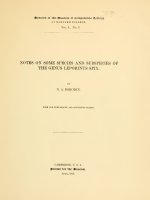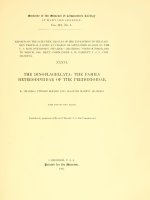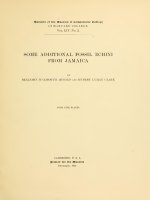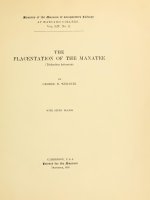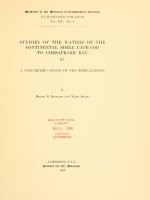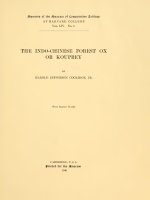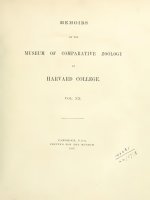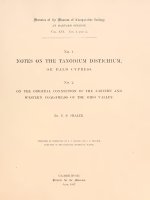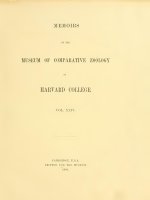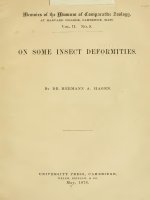Memoirs MCZ 2603
Bạn đang xem bản rút gọn của tài liệu. Xem và tải ngay bản đầy đủ của tài liệu tại đây (2.7 MB, 67 trang )
Umoirs of
ilje
Museum
of
Comnaratibe Zoology
AT HARVARD COLLEGE.
Vol.
XXVI.
No.
3.
REPORTS ON THE SCIENTIFIC RESULTS OF THE EXPEDITION TO THE
TROPICAL PACIFIC, IN CHARGE OF ALEXANDER AGASSIZ, BY THE
U. S. FISH COMMISSION STEAMER " ALBATROSS," FROM AUGUST,
1899, TO MARCH, 1900, COMMANDER JEFFERSON F. MOSER, U. S. N.,
COMMANDING.
III.
MEDUSA
BY
ALEXANDER AGASSIZ
and
ALFRED GOLDSBOROUGH MAYER.
WITH THIRTEEN PLATES, AND A CHART OF THE ROUTE.
[Published by permission of
Gbouge M. Bowbhs,
U. S. Commissioner of Fish aud Fisheries.]
CAMBRIDGE,
$rintcb for
tfje
U.
S.
A.
:
IHusntm.
January, 1902.
Reports on the Scientific Results of the Expedition to the Tropical
Pacific in charge of Alexander Agassiz by the U. S. Fish Commission
Steamer "Albatross," from August, 1899, to March, 1900, Commander
Jefferson F. Moser, U. S. N., commanding.
III.
MEDUSA.
By
ALEXANDER AGASSIZ AND ALFRED GOLDSBOROUGH MAYER.
(Published by permission of Geo. M. Bowers, U. S. Commissioner o£ fish and Fisheries.)
INTRODUCTION.
The medusae
described in the following paper were obtained in thirty-
four surface hauls, and in one bottom trawl
made
at
830 fathoms
in
the
In addition to these there were thirteen intermediate hauls with
Marquesas.
an open net, one at 100 fathoms, five at 150 fathoms, and seven between
250-350 fathoms and the
The hauls
in
surface.
which medusae were captured were distributed
Between San Francisco, Cal., and the Marquesas
Among the Marquesas, Paumotus, and Society Islands
.
Total
.
as follows:
—
EXPEDITION OF THE "ALBATROSS,"
140
1899-1900.
region of the Japan current north of the Ladrones the water teemed with
life,
and the display
fact
it is
phosphorescence at night was truly remarkable.
of
In
evident that pelagic animals are not abundant in regions far from
large land masses or where there are no well defined oceanic currents or
As soon
counter currents.
as one approaches the region of great currents
or counter currents, or the coasts of continents and larger islands, the
number
of animals increases with remarkable suddenness.
was very noticeable that during the daylight hours our surface tows
It
were generally deficient
in
animal
while those
life,
made
at the
same time
with an open net at depths varying between 300 fathoms and the surface
were remarkably rich
obtained.
It
both in
evident that in the regions
is
unknown depth during
animals sink to an
noted that these same animals
surface hauls
made
cessful than those
Among
number and
at night
made
the
we examined
the daytime.
rise to the surface
is
in the
free expanse of ocean
same
It should also
during the night, for our
The
relatively great
In
continents.
number of the
the
open
sea,
however, they
in
the
Rhopolonema, Aglaura, and Liriope,
There were, however, two
young
of
between California and the Marquesas were wonder-
Leptolina forms were captured near some coast or
A
suc-
number
Our hauls
pelagic types.
while yEgina and Solinaris were met with occasionally.
:
be
locality during the day.
fully rich in such Trachylina forms as
rule
pelagic
the
quite striking, for these medusae are rare in waters
coasts of
constituted the greater
archipelago.
specimens
were almost without exception much more
Trachylina and thirteen Leptolina forms.
adjacent to
the
Hydromedusas obtained by the " Albatross," seven are
the twenty
the Trachylina forms
of
variety
Sarsia
where the nearest land
was obtained
(the
in
among
remarkable
N. Lat.
Almost
9° 45',
all
of the
the islands of an
exceptions to this
W. Long.
137° 47',
Marquesas) was more than 1000 miles away
;
In general, how-
and a Tiara was found 600 miles north of the Marquesas.
1
ever, the results support the conclusions of Maas, in the case of the Plankton
Expedition, that Leptolina forms are creatures of the shallower waters near
coasts, while the
1
Trachjdina are animals of the open ocean.
Maas, O., 1893; Craspedoten Medusen der Plankton-Expedition. Also
Marine Animals, Natural Science, London, Vol. II., p. 02—99.
Distribution of
On some Problems
of the
;
.
MEDUSAE.
The following
table will serve to
141
show the extent of our captures:
Number
of Species
obtained.
Hydroinedusse
Number
new
8
4
Siphonophorae
10
4
4
2
42
21
The following forms
Atlantic
by
are represented
of Species
already known.
11
Scyphomeduste
Ctenopborae
Number
of Species
to Science.
20
.
—
21
both the Tropical Pacific and
in
identical or very closely allied
species
:
Aglaura prismatica,
Liriope hyalina, Nausithoe punctata var. pacifica, Abyla quincunx, Necto-
physa Wyvillei
?
DESCRIPTION OF THE SPECIES.
HYDROMEDDS^l.
Sarsia
A
single specimen of a
young
sp.
damaged condition was
Sarsia in a greatly
found on the surface when the nearest land (the Marquesas Islands) was
remarkable that
over 1000 miles away.
It
have been taken so
out upon the open ocean.
S-';
«
far
Station 13
;
is
September
5,.
1899
;
N. Lat. 9°
Tiara oceanica,
Plate
The
bell is
and there
medium
is
size,
acorn-shaped and 5
1
Long. 137°
47'.
1, fig. 1.
mm.
in height.
and sixteen short tentacles.
The
walls are very thin,
There are eight long, eight
The long ones
The medium
;
f
W.
are about as great
tentacles are about one-third as
—
S)
S d indicates a surface tow made in the daytime S" a surface tow made at niirht (150 f
made with an open net dragged between 150 fathoms and the surface during the day
S)" indicates the same made at night.
indicates a haul
(150
57',
form should
sp. nov.
a small, solid, apical projection.
in extent as the bell height.
this Leptolina
—
;
rf
EXPEDITION OF THE "ALBATROSS,"
142
and the small ones are mere rudiments.
long,
The
from the hell-margin.
1899-1900.
All of the tentacles arise
and intermediate ones
basal bulbs of the long
are conical, and each one bears a single ocellus upon
The velum
base.
is
by means
aboral side near the
There are four narrow radial tubes,
well developed.
the mid-regions of which display jagged edges.
the radial canals
its
The
proboscis
is
The
proboscis
is
of four mesenteries.
bound
to
short and
extends only about one-half of the distance from the inner apex to the
The gonads occupy
velum.
four radially
The
surfaces of which are complexly folded.
much
The
folded.
and the
the
four lips are large and are
proboscis and tentacle bulbs are of a delicate purple-pink
A
dark red.
ocelli are
situated linear swellings,
was found about 600 miles
single specimen
north of the Marquesas.
(250
f
—
Station 1G; September
S)'';
9,
1809; N. Lat. 2°
Turris pelagica,
Plate
The
bell
is
mm.
16
wider at the middle than
The
projection.
bell walls are
about thirty short tentacles,
arise
are
no
The velum
ocelli.
flat
any other
is
There
end.
is
very thin and quite
being of the same
size.
a small, solid, apical
flexible.
There are
These tentacles
all
There
conical.
and quite broad, being narrower near the circular canal than
Their outer edges are jagged, excepting in the narrow
place.
part of the bell-cavity.
four mesenteries.
The
It
is
developed, complexly crenulated
light port-wine color,
numerous
lips.
The
and the gonads and
single specimen of this
Station
1
;
by means of
from the inner apex
of the
surfaces of the gonads are
papilla?.
lips
There are four well
and tentacle bulbs are of a
radial canals are of a
medusa was found
August 26; N. Lat. 31°
the greater
radially situated double rows
The outer
transversely folded and give rise to
fills
to the four radial canals
of the distance
opening.
large and
is
The gonads occupy four
bell-cavity to the velar
S'';
proboscis
bound
which extend about two-thirds
A
being
There are four radial tubes
well developed.
parts near the circular canal.
shade.
22'.
sides are barrel-shaped,
from the bell-margin, and their bases are large and
which are
at
all
Long. 137°
1, fig. 2.
either
at
W.
sp. nov.
and the
in height,
38',
10',
W.
still
lighter
in a surface haul.
Long. 125°.
MEDUSAE.
PSYTHIA,
143
gen. nov.
Williadae with four simple unbranched radial canals.
In
all
known genera
previously
The general form,
are branched.
of the family Williadae the radial canals
color,
budding of the present medusa, however,
the Williadae.
may
It
atavistic sport
medusa-buds before attaining
its
Plate
its
may
flatter
give rise
much
shrivelled b}' con-
ascertained.
It
radially situated tentacles, each of
one-half as long as the bell-height.
composed of chordate
cells,
The entoderm of
and a very
fine
throughout the length of each tentacle.
radial canals
;
appeared,
than a hemisphere, and 4 nun. in diameter.
The gelatinous substance was of uniform and only moderate
stiff,
to
1, fig. 3.
exact shape could not be
however, to be slightly
There were four
among
sp. nov.
In the single specimen obtained, the bell was
so that
it
complete development.
Psythia prolifera,
traction,
to place
from some of the more
an immature individual which
or
Williadae,
one
incline
all
be a primitive, or ancestral, form in which the canals
have remained simple, or possibly an
complex
shape of proboscis, and method of
thickness.
which was about
these tentacles
axial canal appeared to
There were four
and a simple, slender, circular canal.
was
extend
straight, simple,
The
proboscis was
cruciform in cross-section, and about three-quarters as long as the height
of the bell-cavity.
The four
lips
were small and slightly recurved.
Four
medusa-bearing stolons arose from the four radial corners of the stomach
very near the points of entrance of the four radial canals.
stolons gave rise to from
When
opment.
tentacles and
about
two
to
to six
radial canals, as in
sprinkled over with nematocyst
stolons
is
ochre-yellow,
of these
in various stages of devel-
be set free the young medusa possesses four simple
trace of the proliferating stolons.
is
medusa-buds
Each
all
the adult
;
but
The ex-umbrella
cells.
its
proboscis shows no
of the
The entoderm
other parts being colorless.
young medusa
of the proboscis
A
and
single specimen
EXPEDITION OF THE "ALBATROSS,"
144
1899-1900.
of this medusa was obtained, in an open net towed between 300 fathoms
and the surface,
i—S) J
(300
off
;
Marokau
Island,
Station 136; October 28, 1899; S. Lat. 18° 08', VV. Long. 141° 49'.
Lymnorea
Plate
The top
as
about
The
broad.
is
it
of the bell
short
fifty
a
The
and the sides
mm.
sp. nov.
9-12.
2, figs.
about 4
is
flare
outward
in diameter,
bell-walls are thin,
and quite
and
in a bell-shaped
is
about as high
flexible.
There are
tentacles which are each about one-half the length of
stiff
entodermal cores are
cells.
ocellata,
These tentacles are usually carried curled upward, and
the bell-height.
their
flat
is
The animal
manner.
Paumotus Group.
and composed of vacuolated chordate
solid
basal bulbs of the tentacles are large, and each one
mass of red pigment.
In addition to this there
is
a prominent ectoder-
mal ocellus upon the ventral (lower) side of each
distance centrifugally from the basal
are four straight, narrow radial
peduncle of the proboscis
is
bulb.
contains
tentacle
The velum
is
at
short
a
There
small.
The
canals and a slender circular tube.
wide and quadratic
cross-section,
in
and
its
lower portion, near the gastric region, consists of highly vacuolated ento-
dermal
cells.
mouth
is
The
gastric part of
a simple round opening.
the proboscis
The
entire
is
pear-shaped, and the
proboscis extends
about
one-half the distance from the inner apex of the bell-cavity to the level
of the velar opening.
one of which
is
There are four well developed
oral tentacles, each
about half as long as the height of the proboscis.
Each
oral
tentacle branches dendritically four times, thus giving rise to sixteen distal
knobs.
Each knob
thickly covered with a bristling cluster of fusiform
cells.
In addition to these there are several patches of nema-
bristles
upon the sides of the main trunk of each oral tentacle.
nematocyst
tocystic
is
The gonads
are developed
of the proboscis.
in four radial
The entoderm
of the tentacle bulbs
The ectodermal
part of
the proboscis
number
of these medusas were obtained
Makemo
Island,
is
regions within the gastric part
brick-red.
and of the gastric
ocelli
are black.
A
on the surface in the lagoon of
Paumotus, on October 23, 1899.
MEDUSAE.
145
Bougainvillia fulva Agassiz and Mayer.
p. 162, PI. 2,
Agassiz and Mater, 1899
fulva
Bougainvillia
Mus. Comp. Zool., Vol. XXXII.,
Bull.
;
Fig. 6.
Plate
2, fig. 8.
individual of this species was found
An immature
by us among the
Fiji
Islands in 1898, and a mature specimen was obtained off Funafuti Atoll,
Ellice Islands, on
The
cal.
bell
is
December
about 6
22, 1899.
mm.
in
The gelatinous substance
height and the sides are straight and vertiis
There
of uniform thickness everywhere.
are four bunches, each containing seven tentacles, which arise from the bases
of the four radial canals.
chordate.
cells are
A
These tentacles are
solid
single dark-colored ocellus
is
and their entodermal
upon the under
situated
The velum
or centripetal side of each tentacle near the basal bulb.
There are four
narrow.
The proboscis
vessel.
is
straight, narrow, radial canals
quadratic, and
its
base
is
is
and a slender circular
wide.
It
extends about
one-third of the distance from the inner apex of the bell-cavity to the velar
Four
opening.
oral tentacles, each of
which branches dichotomously four
times, arise from the four radial corners of the proboscis near the mouth.
The mouth
The entoderm of
proboscis.
The
A
The gonads are
a simple round opening.
is
the proboscis and tentacle bulbs
tentacles are of a translucent milky color, and the bell
single
fathoms
specimen was obtained
in
is
rosin-yellow.
transparent.
an open net towed from a depth
f
—
S)''; Station
195; December
1899; S Lat. 10°
22,
Epenthesis rangiroae,
Plate 1,
The
is
of
150
to the surface.
(150
The
situated in the
bell
bell-walls are thin
and
W.
Long. 179°
is
7
30'.
sp. nov.
Jig. 4-
slightly flatter than a hemisphere,
is
47',
and
mm.
in diameter.
There are sixteen well developed
flexible.
tentacles with large conical basal bulbs.
Sixteen otocysts, each containing
a single spherical otolith, alternate in position with the sixteen tentacles.
The velum
is
broad.
narrow circular
vessel.
There are four
The proboscis
10
straight, slender, radial canals,
is
very short and quadratic
and a
in cross-
EXPEDITION OF THE "ALBATROSS,"
146
and there are four slightly recurved
section,
1899-1900.
The four gonads are
lips.
found upon the four radial canals very near to the circular
single specimen obtained, each
The medusa
eggs.
gonad contained from
six to eight
prominent
transparent with the exception of the proboscis gonads
is
and tentacle bulbs, which are translucent and milky in
was found
In the
vessel.
This form
color.
lagoon of Rangiroa Island, Paumotus, on September 23,
in the
1899.
(150
f— S) d
;
Station 195;
December
22,
1899
;
S. Lat. 10° 47',
Phortis elliceana,
Plate
The
much
bell is
flatter
2, figs.
is
5-7.
the bases of the four radial canals.
mm.
about 16
is
in
There are about
sharp-edged.
is
Four of these are
hollow tentacle bulbs.
30'.
thick at the aboral pole, but becomes
thinner towards the bell-margin, which
fifty-six
Long. 179°
sp. nov.
than a hemisphere, and
The gelatinous substance
diameter.
W.
Twelve others are
three of these are found in each quadrant.
and are situated at
large,
medium
of
size,
and
In addition to these there are
about forty very small rudimentary tentacle bulbs upon the bell-margin.
There are no
marginal
lateral or
which alternate
in
cirri.
There are about
position with the tentacle bulbs.
two or three spherical
The velum
otoliths.
is
fifty-six otocysts
Each otocyst contains
four simple, narrow, radial canals, and a slender circular vessel.
cle is
There are
well developed.
The pedun-
about as long as the bell-diameter, and projects a considerable distance
The
beyond the bell-opening.
basal part of the peduncle has the shape of a
four-sided truncated pyramid, while the distal portion
gradually toward the gastric part of the proboscis.
extend down the angles of the
The
proboscis.
latter
recurved, crenulated
is
proboscis
is
is
The
long, and tapers
four radial canals
peduncle to the gastric portion of the
short and flaring, and there are four well developed,
The gonads
lips.
are linear, and are developed
the sub-umbrella regions of the radial canals.
bulbs and gonads
is
The entoderm of
the tentacle
pink in color, while that of the gastric portion of the
A
rosin-yellow.
single specimen of this
medusa was found
an open net which was towed from a depth of 150 fathoms
to the
f
— Sy
;
Station 195
;
December
22, 1899; S. Lat. 10° 47',
W. Long.
179°
in
surface,
off Funafuti Atoll in the Ellice Islands.
(150
upon
30'.
MEDUSAE.
Rhegmatodes
Plate o,
The
bell
is
sp. nov.
lacteus,
fiys. 15, 16.
than a hemisphere, and
flatter
gelatinous substance
147
about one-tenth as long as the bell-diameter.
tentacles,
These ten-
In addition to these
tacles are provided with large hollow, bulbular bases.
large tentacles there are about 250 very small rudimentary
There
ones.
are about 500 otocysts, each containing two small spherical otoliths.
velum
delicate
is
There are 105
and narrow.
upon the middle and lower regions
stomach
proboscis
mm.
25
is
in diameter,
and the canals
and there are 105 simple
short,
is
arise
5,
1899:
Mesonema macrodactylum Brandt,
Tom. IV.,
p.
A
single specimen
S. Lat.
17°
W.
27',
J. F., 1838;
Long. 149°
32'.
Brandt.
Mem. Acad. Imp.
Petersbourg, Sci. Nat.
St.
359, Taf. IV.
Large numbers of
this
medusa were found swimming
at the surface in
the lagoon of Likieb Atoll, Marshall Islands, on January 20-21, 1900.
tentacles are not quite so long as in Brandt's figures.
canals, tentacle bulbs,
medusa being
the
Pacific,
it
The
tentacles, proboscis,
color.
Mesonema macrodactylum
G,
The
lips.
periphery.
its
The
haul a few miles north of Tahiti.
in a surface
Station 73; October
Ser.
from
The
radial canals,
gonads are developed.
and genital organs are of a translucent milky
was found
narrow
straight,
of which the
A
extends downward
bell,
There are ten well developed
almost to the level of the stomach.
is
The
in diameter.
thick at the apex, but thin at the bell-margin.
is
long funnel-shaped depression, at the apex of the
each of which
mm.
50
is
and
lips is slightly
colorless.
and Chun (1896
;
milky
Brandt describes
Mitt. Nat. Mus.
The
The entoderm of the
in color
;
all
other parts of
this species
from the tropical
Hamburg, Jahrg.
13, p. 7) records
from the coast of Zanzibar.
Polycanna purpurostoma
Agassiz and Mayer.
Polycanna purpurostoma Agassiz and Mayer, 1899
p. 1G9, PI. 8, Figs.
A
single specimen of this medusa, 50
a surface tow
We
found
it
;
Bull.
Mus. Comp.
Zobl., Vol.
XXXII.,
26-28.
made
among
off
Tahaa
mm.
in
diameter, was obtained in
Island, Society Islands, on
the Fiji Islands in December, 1897.
November
16, 1899.
;
EXPEDITION OF THE "ALBATROSS,"
148
1899-1900.
Liriope hyalina Agassiz and Mater.
Liriope hyalina Agassiz and
Mayer, 1899;
Mus. Comp.
Bull.
XXXII.,
Zobl., Vol.
166,
p.
PI. 9, Fig. 32.
Specimens of
this
medusa were found by the " Albatross
quesas, Paumotus, Society, Ellice,
especially
common
We
(300
f— S)",
rf
;
Station 13
"
rf
f
— S)
d
;
September
—
S)'';
1899
7,
"
;
"
137°
«
2° 38',
"
137°
16
9,
"
"
25
"
14,
"
S"
"
31
"
19; S. Lat. 12° 20',
October 22
November
Station 173;
"
W. Long.
Lagoon of Makemo Island,
S. Lat. 18° 55', W. Long.
;
4
;
17; off
December 22;
Station 195;
"
;
January
Bora Bora
very
flat,
Islands, Marquesas.
15'.
Paumotus.
146° 32'.
W.
Long. 179°
30'.
;
paciflca,
3, figs. 13,
Islands.
sp. nov.
U.
being about three times as broad as
The
in diameter.
22'.
Island, Society Islands.
S. Lat. 10° 47',
Plate
bell is
144°
1897-98.
47'.
Lagoon of Funafuti, Ellice Islands.
1900; Lagoon of Likieb Island, Marshall
25
20,
57',
Between Ua Iluka and Marchand
Dipleurosoma
mm.
137°
6° 41',
"
S";
23
W. Long
"
S";
S"
The
X. Lat. 9°
S";
S";
(150f
this species in the Fiji Islands in
5,
"
14
;
S";
(100
found
and they were
;
open ocean between California
in the tropical part of the
and the Marquesas.
S
S
and Marshall Islands
" in the Mar-
surface of the ex-umbrella
it
is
high, and
by a
reticulated
is
regular system of hexagonal elevations bounded by shallow furrows.
There
are about one hundred short tentacles with narrow bulbular bases.
entodermal core of these tentacles
At
is
solid
and composed of chordate
the bases of most of the tentacles, upon the lower side, there
black ocellus.
is
otoliths.
cells.
a single
Slender club-shaped sensory bodies are scattered at frequent
and irregular intervals between the tentacles.
bodies
is
The
solid,
and very similar to that of the tentacles.
The velum
is
narrow.
from diametrically opposite
the eight canals.
The gonads
bifurcate,
There are no
In the single specimen
and thus eight canals reach the
are linear and occupy the middle region of
Their surfaces are slightly papillate, and the ova stand
out as hemispherical protuberances.
direction of the
core of these
Six radial canals arise in groups of three
sides of the stomach.
examined two of these canals
circular vessel.
The entodermal
The stomach
two opposed groups of
radial
is
canals.
elongated
in
the
The proboscis
is
149
MEDUSAE.
very
short,
bulbs, genital organs,
and proboscis are milky white,
A
medusa being transparent.
haul about
is
tentacle
other parts of the
in a surface
miles north of Tahiti.
fifty
Plate 4,
bell
all
was obtained
single specimen
Geryones mexicana,
The
The
six small, slightly crenulated lips.
and there are
fig.
broad and pear-shaped and
gelatinous substance
is
17.
mm.
about 5
is
The
in diameter.
very thick at the aboral pole, but becomes thin
There are
near the bell-margin.
nov.
sp.
six large, hollow, interradial tentacles, the
centrifugal sides of which are provided with wart-like nematocyst-bearing
There are
swellings.
arises
from the
also six slender, solid radial tentacles, each of
There
above the margin.
side of the bell at a short distance
which
are six otocysts which are situated near the bases of the six interradial tentacles.
Each otocyst contains a
developed.
There are six straight
The entoderm
observed.
tentacles
and there are
The
is
of a
delicate
proboscis
A
pink.
well
radial
is
short and
No gonads were
six slightly recurved lips.
of the proboscis,
is
which are wider near the
radial canals
proboscis than they are near the circular vessel.
lacks a peduncle,
The velum
single spherical otolith.
and interradial
canals,
medusa was
single specimen of this
obtained in a surface haul off the coast of Mexico.
S<*;
Station 3
;
August
28, 1899
;
N.
Lat. 26° 18',
Carmaris rosea,
Plate
The
bell is hemispherical,
nous substance
is
margin, which
is
W.
Long. 128°
54'.
sp. nov.
4, fig. 18.
and about 6 mm.
in diameter.
The
gelati-
thick at the aboral pole, but diminishes toward the bell-
sharp-edged.
There are twenty-four
twenty-four distinct lappets upon the bell-margin.
between each successive pair
of tentacles.
Two
incisions,
forming
lappets are situated
There are twelve
tentacles.
Six
of these, which are long, flexible, and hollow, are situated at the bases of
the six radial canals.
nematocyst
cells,
These tentacles are thickly covered with rings of
and are about as long as the bell-diameter.
The
six other
EXPEDITION OF THE "ALBATROSS,"
150
tentacles are solid, and are interradial in position.
1899-1900.
Their centrifugal sides
are studded with about six to ten wart-like, neinatocyst-bearing swellings.
These tentacles are about as long as the
stiffly
There are twelve otocysts, one
upwards.
Each otocyst
six broad,
developed.
and are carried curled
at the base of each tentacle.
There are
hollow and contains a single spherical otolith.
is
flat,
bell-radius,
upon the mid-regions of which the gonads are
radial canals,
In addition to
the
are eighteen blindly
canals there
radial
between each successive pair of radial
ending centripetal canals, three
Six of these centripetal canals are longer than the others, and
canals.
extend about half the distance from the bell-margin to the base of the
stomach.
The
The
proboscis
circular canal
The velum
flat.
is
well developed.
long and pyriform, and the mouth projects beyond the level
is
The mouth
of the velar opening.
narrow neck, and there are
of the medusa
wide and
is
situated at the extremity of a long
is
of a delicate rosy-pink,
is
and
A
other parts are colorless.
all
was found in a surface haul made south
single specimen
The entoderm
six short, slightly recurved lips.
Marquesas
of the
Islands.
S'';
Station 31
;
September
19,
1899
S. Lat. 12° 20',
;
W. Long.
144°
15'.
Aglaura prismatica Maas.
Aglaura prismatica Maas, 1897; Mem. Mus. Comp.
XXTIL, No.
Zool., Vol.
1,
p.
24, PI.
III., Figs. 4, 5.
We
thereafter
it
became one
it
to be
commonest
of the
among
bers were obtained
we found
c
obtained this medusa in N. Lat. 12
first
7',
W. Long.
137° 18'
objects in the tow.
;
and
Large num-
the Marquesas and Society Islands, and in 1897
abundant among the
Fiji Islands.
1
It
was discovered
in
considerable numbers by the "Albatross" off the west coast of Mexico and
Central America in 1891, and
it
seems
safe
to
conclude that
it
is
distributed over the tropical regions of the Pacific.
SJ
(300
f
September
4,
1899
S'';
"
13;
"
5,
"
S";
"
15;
"
8;
— S)";
"
25;
"
73
S"
S"
1
;
Station 12
;
;
Bull.
;
;
"
October 5
November
14
;
N. Lat. 12°
1
7
;
off
18'.
137°
47'.
"
4° 35',
"
136°
54'.
Islands.
W.
Bora Bora
Mus. Comp. Zool., Vol. XXXII.,
Long. 137°
"
Marquesas
;
W.
9° 57',
S. Lat. 17° 27',
;
07',
"
Long. 149°
32'.
Island, 'Society Islands.
p. 1G5, PI. 4,
Fig
13.
widely
MEDUSA.
Mgina,
Two
151
sp.
specimens of iEgina were obtained
dragged from 250 fathoms
diameter, and
tentacles.
One
to the surface.
f
—
S)
;
too
much damaged
Station 1G; September
9
;
Solmaris
were brought up
in
were of a milky-yellow
much damaged
N. Lat. 2°
38',
W.
Long. 137°
22'.
the other 40
mm.
in
diame-
sixteen tentacles, and the gonads
Unfortunately the margins of their
color.
bells
were
for specific identification.
1,
1899; N. Lat. 17°
Solmissus marshalli,
Plate
5,
Jiffs.
32',
W.
Long. 135°
40'.
sp. nov.
33-25.
disk consists of a thick doubly convex, central portion, and a thin
mm.
outer annulus or collar region, and
is
00
nous substance of the central region
is
very
region
in
sp.
They each had
(150 f—S)''; September
The
them was 28 mm.
an open net which had been dragged between 150
fathoms and the surface.
too
of
for description.
Two specimensof Solmaris, one 25 mm. and
ter,
an open net which was
they both possessed four slender, slightly greenish-colored
They were
(250
in
is
flexible.
Fourteen equally spaced
periphery of the central disk.
conical insertion base.
rigid,
stiff
diameter.
in
The
gelati-
while that of the collar
tentacles arise from the
Each tentacle possesses a well developed
The entodermal
cells
of the tentacles are chordate,
and are very thin and much crowded together.
A
well developed peronial thickening extends radially outward from the
base of each tentacle to the outer margin of the collar region.
Owing
to
the specimen being in a somewhat imperfect condition, only one sense organ
could be observed upon the outer edge of the collar region.
contained a single highly refractive otolith of remarkably small
velum
is
well developed, and
animal through the water.
its
This one
size.
The
powerful contractions serve to propel the
The stomach
is
wide and
flat,
and gives
rise to
fourteen radiating pockets which are situated in the radii of the tentacles.
EXPEDITION OF THE "ALBATROSS,"
152
The mouth
is
a simple round opening at the centre of the sub-umbrella.
The fourteen gonads are
situated at the centripetal edges of the fourteen
The gonads and
stomach pockets.
while
1899-1900.
tentacles are slightly milky in color,
A
other parts of the medusa are transparent.
all
obtained off Kwajalong Atoll, Marshall Islands.
single specimen was
came up
It
in
an open net
which had been towed between 150 fathoms and the surface.
(150f
— S)f
Station 220; January 1G, 1900; N. Lat. 8° 38',
;
Rhopalonema typicum
Homceonema typicum Maas,
Mem. Mus. Comp.
1897;
W.
Long. 167°
37'.
Maas.
Zobl, Vol. XXII.,
p.
22, Taf.
III.,
Figs. 1-3.
Plate 5,
Maas
with
found
describes this species from the west coast of Mexico.
on September
it
especially
common
3°
abundant about
bell
projection.
is
7,
1899, at N.
lat.
made
in surface hauls
north of the equator
at night,
We
long. 137°.
in
W.
The
largest
specimen
are very thin but are remarkably
of
stiff
20
mm.
and
is
We
also
It
was
a small solid apical
by us was about 15 mm.
The
in breadth.
rigid,
bell-walls
swimming being accom-
by means of the strokes of the powerful velum which
ingly flexible.
met
long. 137°.
obtained
Maas records one
first
and appeared to be most
broad and hemispherical, and there
in diameter, but
plished
W.
6° 41',
Marquesas and Paumotus Islands, and at Tahiti.
at the
it
The
21-22.
figs.
is
exceed-
There are eight well developed tentacle bulbs situated at
In addition to these there are about
the bases of the eight radial canals.
twenty-five or thirty smaller tentacles which are interradial in position.
seems probable that the shafts of
all
of the tentacles
were broken
the specimens found by us, leaving only the basal bulbs.
It
off in all
There are about
sixteen exceedingly small otocysts upon the bell-margin, each one of which
The velum
contains a single spherical otolith.
of
its
powerful muscles cause
it
The
proboscis
rower than the mid-region.
is
large, and the contractions
to vibrate with
well developed system of circular muscles
sub-umbrella.
is
is
found
remarkable rapidity.
in the
A
ectoderm of the
urn-shaped, the proximal part being nar-
There are four recurved
lips.
There are
gonads, one upon the middle region of each of the radial canals.
six
Young
MEDUSAE.
153
individuals are of a glassy transparency, while older ones are slightly trans-
lucent and milky in color, especially in the proboscis, gonads, and marginal
tentacles.
s*
September
7,
15;
"
8,
"
16;
"
9,
"
"
31;
"
19,
"
"
32;
"
20,
"
Station 14
s»
"
s»
s»
S"
;
1899
"
S"
"
23,
s»
"
24,
October
S"
;
41',
"
4°
35',
"
"
2° 38',
"
137°
S. Lat. 12° 20',
"
144°
15'.
"
145°
42'.
"
"
13°
37',
Long. 137°.
136° 54'.
22'.
Lagoon of Rangiroa Island, Paumotus
Avatoru pass, Rangiroa.
"
off
"
off Pt.
5,
W.
N. Lat. 6°
Islands.
Venus, Tahiti.
SCYPHOMEDUS-E.
Charybdea grandis,
Plate
The
Adult Medusa.
It
is
is
interradial,
is
of a
wing-like
mm.
A
them
into
flexible
distal
end
mm.
broad
the
sides of
which extend outward
mm.
The
pedalium.
the
long, and
its
of the
portion
surface
(Fig.
is
28).
tentacle,
flexible
part of
which
arises
and
Four sense
organs,
knob-shaped and
is
is
about
ringed and covered with transverse rows
or
rhopalia
is
(Figs.
Each sense organ
from a deep niche situated about 27 mm. above the
The sense organ
from the
the tentacle
29, 30), alternate in position with the four tentacles.
velarium.
long,
wide canal extends through the substance of each of
of nematocyst cells
arises
There are four
These pedalia are each about 40
25 mm. wide.
of
The gelatinous substance
in diameter.
remarkably tough consistency.
pedalia,
in a radial direction.
the
26-31.
high and cone-shaped, with a blunt apex.
is
230 mm. high, and 140
quite thick and
140
bell
6, figs.
sp. dov.
level of the
mounted upon
a short
stem, and contains from one to three ectodermal ocelli, and an entodermal
otolith.
In old medusae there
organ, but in a
and two small
is
usually a single, median ocellus in each sense
young specimen 30 mm.
lateral ocelli.
objects within the bell-cavity.
pended by four mesenteries, or
Twenty-four short
These
in
height there was a large median,
ocelli are all directed so as to
The velarium
is
perceive
well developed and
is
sus-
frenulae, in the regions of the sense organs.
tree-like velar canals (Figs. 26, 31)
extend centripetally
154
EXPEDITION OF THE "ALBATROSS,"
1899-1900.
The
proboscis
inwards into the substance of the velarium.
there are four slightly recurved
short,
is
and
There are four interradial crescentic
lips.
areas of numerous, short gastric cirri; the horns of each crescent pointing
outward from the stomach.
radial pouches extend
Four wide
centripetally.
These pouches are separated one from another by four interradial
partitions,
but are placed in communication one with another by means of the lateral
lumen of the
canals leading into the
leaf-like folds
The gelatinous substance of
the bell
translucent and milky white, and the gastric
is
deep
rhopalia are dull ochre in color and the ocelli are
We
of
Fakarava Island, Paumotus.
of
mature individuals
This species
(300
f
— S)
rf
;
far the largest
solid,
Eight
stiff
14,
1899;
off
Fakarava
"
15,
"
off
Anaa
quite
tentacles,
flat
and
is
17
sp.
mm.
is
Paumotus.
Paumotus Islands.
nov.
in
diameter.
interradial
short
cirri.
is
The mouth
a cruciform
slit
groups of gastric
with the
lips.
Each of
There are eight
about as long as the bell-radius.
tentacles.
is
Each sense
There are
otolith.
sixteen prominent marginal lappets which alternate in
sub-umbrella, and
swarm
33.
7, fig.
each of which
tentacles and sense organs.
a large
Atoll,
Island,
marginal sense organs alternate with the
in position
— almost
to the surface, south
organ contains a centripetal ocellus and a centrifugal
Four
of the
Charybdea known.
October
Plate
is
flexible
Island, floating very near the surface of the
Nausithoe picta,
bell
and
brown
The next day we discovered
Anaa
off
by
is
S*;
The
cirri
The
found a single specimen of this medusa in an open net
first
which had been towed from a depth of 300 fathoms
sea.
hyaline.
is
The sensory knobs
parts of the tentacles are pink or yellow-pink.
black.
consist of eight
attached to the sides of the interradial septa? and hanging free
in the radial pockets.
entoderm
The gonads
pedalia.
position
with the
situated at the centre of the
surrounded by four simple, short
cirri
lips.
are arranged so as to alternate
these groups contains about a dozen
There are eight large gonads which
In the female the ova are large and prominent.
lie in
the tentacular radii.
In the sub-umbrella there
MEDUSA.
is
155
a well developed system of circular muscles which forms a ring, the outer
circumference of which meets the bases of
edge coincides
in position
the tentacles, while the inner
with the middle points of the gonads.
In addition
to these circular muscles there are sixteen strands of radial muscles
which
extend outward on either side of the gonads to the middle of the lappets.
There are
muscle strands in the ex-umbrella which extend
also eight radial
outward toward the sense organs, and
in addition to these there are eight
well developed groups of radial muscles at the bases of the eight tentacles.
The stomach
and
wide lenticular space at the centre
consists of a
pouches extending outward
this gives rise to eight radial
Each of these pouches
the eight sense organs.
of branches into the lappets,
bell
brown
color,
bifurcates and sends a pair
The
ocelli
cirri
are dark blue.
specimens, one male and the other female, were found at night on the
15° 22',
Rangiroa Island, Paumotus, on September 24,
W.
Nausithoe punctata
XXXII., p. 170.
var. pacifica
eight
disk
is
quite
flat
tentacles which
solid
Agassiz and Mayek.
Agassiz and Mayer, 1899
var. pacifica
Plate
The
and
is
are
about 4
quite
on the sub-umbrella edge of the disk.
lappets,
two between
The eight sense organs
situated
at
the
mm.
rigid.
Eight gonads
in
Mus. Corap.
Zool., Vol.
each
There are
in diameter.
These tentacles are each
They
arise
from sockets
successive
pair
of
sense
cleft
organs.
alternate in position with the eight tentacles, and
bottom of the niches between the lappets.
ova are large and
opening
Bull.
There are sixteen sharply
sense organ contains a centrifugal otolith and
ocellus.
;
7, fig. 3<2.
about three-quarters as long as the bell-diameter.
marginal
in S. lat.
long. 147° 57'.
Nausithoe punctata
the
The
and gonads are of a rich
and the entodermal core of the gastric
surface south of
are
in the radii of
in all sixteen terminal pouches.
translucent and milky in color.
is
Two
making
of the disk,
lie
in
a
centripetal dark-brown
the eight tentacular radii.
prominent.
The mouth
Each
is
a
In the female
simple
cruciform
the centre of the sub-umbrella, the arms of the cross, passing
through two
of the tentacular diameters.
There are four groups of gastric
'
EXPEDITION OF THE "ALBATROSS,"
156
which alternate
cirri
position
in
with the
these groups contain from four to seven
is
slightly bluish or
milky
in color,
Each of
of the medusa.
lips
The gelatinous substance
cirri.
and the genital organs are dull cream or
In the majority of specimens there are no spots
slightly ochre colored.
upon the ex-umbrella, but
upon the upper surface
differ
1899-1900.
in
some there
a brownish or yellowish spot
is
This form appears to
of each of the eight lappets.
from the Atlantic-Mediterranean species only
in its duller coloration
and the frequent absence of spots upon the ex-umbrella. Compare the Figure
we
here present with the drawing of the Atlantic species given in the Bull.
Mus. Comp. Zool., Vol.
We
XXXVIL,
Plate 26, Fig. 87.
obtained this medusa in considerable numbers in Neiafu Harbor,
Vavau
Island,
among
the Fiji Islands in December, 1897.
Tonga, on December 5 and
specimen obtained near Suva,
1899, and
we
Our Figure
is
6,
also found
it
taken from a
Fiji.
Atolla Alexandri Maas.
Fig.
Atolla Alexandri Maas, 1897
2, Taf. XIV., Figs. 4, 5.
A
at
;
Mem. Mus. Comp.
single specimen, in good condition,
Zool., Vol. XXIII.,
was brought up
No.
1, p.
81, Taf.
XI,
bottom trawl
in a
830 fathoms between Ua Huka and Marchand Islands, Marquesas, on
September
14, 1899.
was 24 mm.
It
diameter, and there were forty-
in
A
eight marginal lappets and twenty-four tentacles.
of this deep-sea form
made
off
number
were obtained by the "Albatross"
in
of specimens
1891
in trawls
the Pacific coasts of Mexico and Central America.
Linerges aquila Haeckel.
Linerges aquila Haeckel,
An immense swarm
diameter, were
found
October 27, 1899.
with
in
of
in
ephyra)
the
Syst. der
E., 1880;
of this
lagoon of
Medusen,
p. 496.
species, all
Ilikueru
about 3
Island,
mm.
in
Paumotus, on
Another swarm of somewhat older medusa? was met
the lagoon of Funafuti, Ellice Islands, on
December 24-25; and
a single mature individual was captured in the lagoon of Rongelab Atoll,
Marshall Islands, on January 17, 1900.
We
ephyra) and mature medusae of this species
1
found large numbers of both
among
Agassiz and Mayer, 1839; Bull. Mus. Comp. Zool., Vol.
the Fiji Islands in 1897.
XXXII.,
p. 170, PI. 10, Figs. 33, 34.
MEDTJS.E.
Zonephyra corona,
Plate
The
bell
a
is
becomes
but
umbrella
short
near
thinner
hollow
nov.
more than a hemisphere and
little
the
and
tentacles
is
quite
thick
nematocyst
eight
marginal
in
aboral pole,
the
surface
of
the
ex-
There are eight
cells.
Each sense
organs.
sense
mm.
about 15
is
at
The
bell-margin.
with
thickly sprinkled
is
sp.
4, figs. 19, 20.
The gelatinous substance
diameter.
157
organ contains an entodermal mass of red-colored granules.
There are
thirty-two broad lappets, two between each successive tentacle and sense
The sub-umbrella
organ.
provided with a well developed set of circular
In addition to these there are sixteen spear-head-shaped radial
muscles.
muscle
is
strands
strands are
in
sub-umbrella
the
;
the
ends
broad
of
these
muscle
These strands extend to the notches between
centripetal.
each successive tentacle and sense organ.
Sixteen narrow radial muscle
strands are also found in the ex-umbrella, and they alternate in position
The
with the strands of the sub-umbrella.
shaped, and
there
are four
proboscis
recurved, crenulated
is
broad and
The
lips.
flask-
four gonads
are interradial in position and are horseshoe shaped, the concavity being
directed outward.
Each gonad
is
thrown into complex corrugations, and
in
the female the eggs are easily seen on account of their deep purple color.
Each gonad
provided with from eight to ten gastric
is
cirri.
The
gastro-
vascular cavity extends outwards in thirty-two pockets, one in each lappet.
The
gelatinous substance of the bell
is
of a greenish-amber tinge.
The
entoderm of the tentacles and the sensory entoderm of the marginal sense
organs
is
of a claret color, as are also the eggs.
gastro-vascular cavity
is
The
of a delicate claret color,
entire entoderm of the
and the radial muscle
strands of the sub-umbrella are of a glistening white.
of this
medusa was found.
It differs
A
single specimen
from the two species described by
Haeckel, 1880, in that there are thirty-two lappets instead of sixteen as in
Haeckel's forms.
Sd
;
Station 14
;
September
7,
1899; N. Lat. 6°
41',
W.
Long. 137°.
EXPEDITION OF THE "ALBATROSS,"
158
Pelagia tahitiana,
Plate
Immature
about 16
The
individual.
mm.
sp. nov.
8, Jigs. 34, 35.
disk
twice as broad as
is
The ex-umbrella
in diameter.
1899-1900.
is
it
high, and
is
is
quite regularly sprinkled
over with large wart-like papillae which bear nettling
cells.
The
papillae
near the aboral apex of the disk are larger than the others, those near
the bell-margin being very
distal
three-quarters of
There are eight hollow
small.
tentacles, the
which are covered profusely with nettling
cells.
These tentacles are each about three-quarters as long as the bell-diameter.
Eight marginal
sense organs
organ contains a mass of dark-red
There are sixteen
partially
four well developed
long as the
of
which
is
Each
(centripetally).
entodermal
The mouth
There are four
shaped,
gonad
of
is
palps which are about
crenulated
horseshoe
pigment
cleft lappets.
bell-diameter.
Each sense
alternate with the tentacles.
with
is
furnished
gonads, each one
inter-radial
with
pit.
outward
turned
from eight
short gastric cirri and a well developed sub-genital
a wide lenticular space at the centre of the disk.
surrounded by
three-quarters as
concave side
its
formation.
to
twelve
The stomach
is
It gives rise to sixteen
radial pockets
which extend outward, eight
sense organs.
These pockets are entirely separated each from each, and there
is
no ring
There
canal.
is
to the tentacles
and eight
to the
a well developed set of circular muscles in the
sub-umbrella, and also a powerful radial set of sixteen muscle strands which
alternate in position with the tentacles and sense organs, and extend
the septaa between the radial pockets.
radial
muscle strands
In addition to these there are sixteen
in the ex-umbrella.
tentacles and sense organs.
The
down
These extend
to the bases of the
disk and palps are of a dull amber-yellow
color and the tentacles are of a darker hue.
The nematocyst
cells
over the
ex-umbrella and the palps are orange-red, and the genital organs are of a
A
dull ochre color.
single specimen of this
medusa was found on the
face south of Rangiroa Island, Paumotus.
S"
;
September
24,
1899
;
off
Rangiroa, Paumotus Islands.
sur-
MEDUSAE.
159
Aurelia vitiana Agassiz and Mayek.
Aurelia vitiana Agassiz and Maykk, 1899;
Mus. Comp.
Bull.
XXXII.,
Zobl., Vol.
p.
171,
Plate 10, Fig. 85.
This species was very abundant upon the surface during the afternoon
hours in Neiafu Harbor, Vavau Island, Tonga, on December 5 and
None were
Fiji, in
We
be seen in the morning.
to
December, 1897
but here
;
it
found
was very calm while we were
come
also in
1899.
Suva Harbor,
appeared during the early morning
hours, and then only on perfectly calm days.
it
it
6,
in Neiafu
It
interesting that although
is
Harbor, yet the medusa? did not
morning, but swarmed there during the afternoon.
to the surface in the
SIPHONOPHORE!.
Porpita pacifica
Porpita pacifica Lesson, R.
Figs.
P.,
1830
Voy. de
;
Lesson.
la " Coquille," Zool.,
Tom.
2,
Zoophytes,
PI. 7,
3, 3'.
This species
The general
is
widely distributed over the tropical belt of the Pacific.
pneumatocyst and
color of the
more yellowish than
S"; Station 7;
"
S< (
13;
"
September
31;
S ';
1
1,
1899; N. Lat. 18°
"
9°
"
19',
W.
Long. 134°
57'.
57',
"
137° 47'.
"
S. Lat. 12° 20',
"
144°
"
off
"
5,
"
19,
1 7,
25,
"
November
December
S";
not so gray but
in Lesson's figure.
;
S'';
pol_ypit.es is
15'.
Bora Bora Island, Society Islands.
Lagoon of Funafuti Atoll, Ellice Islands.
"Velella pacifica Eschscholtz.
Velella pacifica Eschscholtz, F., 1829
Sd
S
;
rf
;
Station 14
;
September
7,
November
16,
;
Syst. der Acalephen.
1899; N. Lat. 6°
"
Tahaa
41',
W.
Long. 137°.
Island, Society Islands.
EXPEDITION OF THE "ALBATROSS,"
160
1899-1900.
DIPHYOPSIS APPENDICULATA.
ERS^EA APPENDICULATA.
Diphyopsis appendiculata Agassiz
and Mater.
Diphyes appendiculata Eschscholtz, F., 1829; Syst. der Acalephen, p. 138, Taf. XII., Fig.
Diphyes appendiculata Huxley, T. H., 1859 Oceanic Hydrozoa, p. 34, PL I., Figs. 2-2=.
7.
;
Plate 9,
This species was
W.
it
hit.
17° 32',
continued to be abundant throughout the tropical
In the Pacific species the entoderm of the polypites
regions of the Pacific.
and nematocyst batteries
in the Atlantic
38, 39.
obtained by the "Albatross" in N.
first
long. 135° 40', and
figs.
milky, or slightly yellow or pink in color, while
is
form the potypites are of a more or
green and
less intense
the nematocyst batteries of the tentacles are yellow or orange (see Bull.
Mus. Comp. Zool., Vol. XXXVII., No.
important difference between the two species
Pacific
a
manubrium within
Pacific form, therefore,
to the
more
the fact that in the
swimming-bell
it
;
possesses a
while in the Atlantic form
manubrium within
form belongs
a Diphyopsis, while the Atlantic
is
its bell.
genus Diphyes.
The animal
is
its
belongs to the genus Eudoxia, for
The
lies in
still
form the monogastric sexual generation belongs to the genus Erssea,
and lacks
it
A
34, Fig. 114).
2, PI.
somewhat
18-20 mm.
in
its
cavity
is
The
oil
anterior bell
angular and
is
There are two ascending, curved
voluminous.
and a simple circular
narrow and contains an "
and the anterior swimrnins;-bell
lens;th,
larger than the posterior.
pyramidal and
radial canals
is
The phyllocyst
vessel.
globule " near
its distal
is
extremity.
long and
There
is
a moderately deep conical hydrcecium upon the ventral face of the anterior
Hectophore, and the siphosome arises from
dage of the siphosome
This
is
is
somewhat smaller than the anterior
Indeed the siphosome
the covering tooth.
lies
side
bell,
The
first
appen-
s,
and a deep groove covered
upon which the siphosome
within this groove and
The second appendage
auxiliary swimming-bell («
cluster of
inner apex.
the large posterior swimming-bell (ps, Fig. 39).
by a projecting tooth runs down the
ated.
its
Fig. 39).
of the
protected
is
siphosome
Immediately below
is situ-
is
this
by
the small
comes a
immature feeding polypites, the older ones being successively
MEDUSA.
lower down the siphosome.
poly"pites,
The
tentacles
161
bud out from the
and then come the bracts which protect them.
the siphosome are separated by free internodes.
appendiculata, each unit
is
provided with a covering
and immature swimming-bell.
When
The
sides of the
units
upon
set free as Ersoea
scale, polypite, tentacle,
